“US recognition of severed Kosovo province was a serious mistake, leading to an escalation of tensions, instead of calming down the situation in the Balkans … consensus boils down to the fact that nobody knows where Kosovo is” (John Bolton)
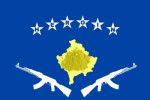
The International Institute for Middle-East and Balkan Studies (IFIMES) in Ljubljana, Slovenia, regularly analyses events in the Middle East and the Balkans. IFIMES has now prepared an analysis of the current political situation in Kosovo. The most relevant and interesting sections from the comprehensive analysis entitled “Kosovo 2019 early parliamentary election: the citizens want political changes” from this LINK: https://www.ifimes.org/en/9701
IFIMES believes that the forthcoming early parliamentary election will be the most uncertain parliamentary election since the Republic of Kosovo proclaimed independence. According IFIMES the main task of the new government will be to stop the negative trends in almost every segment of the Kosovo society. The incumbent coalition government (PDK-AAK-AKR-Nisma) has proven to be incapable of resolving the challenges that Kosovo is facing. After 19 years in power they are now characterised by crime, corruption and nepotism. Two billion euros of EU taxpayers’ money have disappeared or been inappropriately wasted in Kosovo… Kosovo urgently needs to carry out decriminalisation of politics.
The Kosovo Assembly
The Kosovo Assembly (parliament) has 120 members, of which 20 seats are reserved for representatives of minority communities as follows: 10 seats for the Serbian community, 3 for the Bosniak community, 2 for the Turkish community, 4 for the Roma (RAE – Romani, Ashkali and Egyptians) and 1 for the Gorans. There are 1,060 candidates competing for the 120 seats in the Assembly. 46,917 voters have been removed from the electoral roll, either because they are deceased or they have renounced Kosovo citizenship since the 2017 local election.
In the Kosovo Central Election Commission’s (CIK) electoral roll for the forthcoming early parliamentary election there are 1,937,869 voters in 38 municipalities with altogether 1,780,021 inhabitants. Kosovo citizens in the diaspora have the right to vote. So from electoral roll one can find out that there are more voters than inhabitants in the country. There will be 20 political parties, four coalitions and one independent candidate from the Bosniak community competing at the election.
The Kosovo election law is not promiting democracy either; it prevents the formation of coalitions after elections while it enables pre-election coalitions. For example the Constitutional Court of Kosovo stated that the formation of post-election coalitions was unconstitutional, while in Albania it is unconstitutional to form pre-election coalitions. In any developed – Western – democracy this practices are quite unique.
Election 2019
According analysis by IFIMES the main race at the upcoming parliamentary election in Kosovo will take place between the three main political rivals: Isa Mustafa’s Democratic League of Kosovo (LDK), Albin Kurti’s “Vetëvendosje” Self-Determination Movement (LVV) and Kadri Veseli’s Democratic Party of Kosovo (PDK). Besides those main three rivals, Ramush Haradinaj with his Alliance for the Future of Kosovo (AAK) is trying to enter the race as the fourth competitor.
The public opinion polls carried out in Kosovo have shown a strong downwards trend in PDK’s popularity and the party is now competing for the third place with AAK. Very small differences between LDK and LVV shown in pre-election surveys mean that the winner will be decided in the final part of the campaign. Especially the young generation has recognised refreshment in the political scene through political parties that have not yet participated in the government of Kosovo, such as LVV and its leader Albin Kurti. If LVV and LDK can get mayority in Kosovo Assembly it could be possible to form LVV/LDK coalition – theoritically, as the problem is that one part of LDK’s officials are in close connection with criminal structures in PDK and AAK and want to form coalition with them.
According analysis by IFIMES ”most undecided voters share the opinion that the incumbent coalition government (PDK-AAK-AKR-Nisma) should be punished for their unprincipled coalition and their connections with crime, corruption, nepotism, intimidation, threats, war crimes, liquidations and extortions. The incumbent government has left nothing but many empty promises and the damage to be paid by future generations of Kosovars.”
Analysts believe that the rule of law in Kosovo is not functioning and that there are no justice, no penalties and no efficient courts. Kosovo citizens live in fear as hostages to the political-criminal structures and (para)military and (para)intelligence units that are symbolised by Kadri Veseli (PDK).
The roots of crime in Kosovo
After Kosovo war – during my work there – the [Western] international community aimed to development of the state, promised to build strong institutions inner and regional stability and peace as outcome, thus contributing to stability and peace in the region. They totally failed which is not a surprize as nowhere in the world have political-criminal structures built strong institutions.
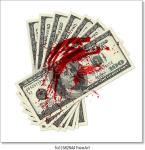
When the US State Department listed the Kosovo Liberation Army (KLA) as a terrorist organization in 1998, the reason wasn’t radical Islam but its links to the heroin trade. By 1999, Western intelligence agencies estimated that over $250m of narcotics money had found its way into KLA coffers. After the NATO bombing of 1999, KLA-linked heroin traffickers again began using Kosovo as a major supply route; in 2000, an estimated 80% of Europe’s heroin supply was controlled by Kosovar Albanians.
Western intelligence agencies warned that Hashim Thaci ran an organised crime network in the late 1990s, they knew the KLA were criminals running the drug, slave, and weapons rackets throughout Europe, they knew the KLA was supported by Osama bin Laden (with whom Thaci met personally in Tirana in 1998 to plan the jihad in Kosovo. Despite this Western political leaders backed his Kosovo Liberation Army and its members were transformed as “freedom fighters”.
The main source of organised crime are the former commanders of Kosovo Liberation Army (UÇK) and (para)intelligence services (ShIK) in cooperation with political structures. For example ShIK was not dissolved in 2008 as planned. Also former commanders raised during war huge amounts of money through various sources such as drug smuggling and these funds are still controlled by leading tribe- now political leaders of the Democratic Party of Kosovo (PDK) and by the Democratic League of Kosovo (LDK).

Many countries have seen through this whitewashing of crime-money and this has e.g. stopped international recognitions for the past five years. According WikiPedia as of 27 July 2019, the Republic of Kosovo has received 115 diplomatic recognitions as an independent state, of which 12 have since been withdrawn. As of 17 August 2019, 100 out of 193 (52%) United Nations (UN) member states, 23 out of 28 (82%) European Union (EU) member states, 25 out of 29 (86%) NATO member states, and 34 out of 57 (60%) Organisation of Islamic Cooperation (OIC) member states have recognized Kosovo.
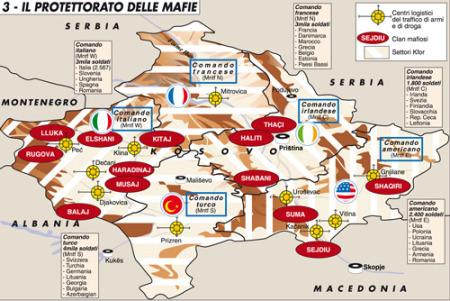
Mafia Clans/KFOR sectors -map made by Laura Canali
Quadruple Helix Model
In my earlier article Quadruple Helix – Capturing Kosovo I described how (Kosovo) Albanian organized crime organizations gained remarkable role in Europe. It is estimated that they are the chief perpetrator of drug and people smuggling, trafficking, organ sales etc. Past estimates suggested that ethnic Albanian traffickers controlled 70% or more of the heroin entering a number of key destination markets, and they have been described as a “threat to the EU” by the Council of Europe at least as recently as 2005. In fact, ethnic Albanian heroin trafficking is arguably the single most prominent organized crime problem in Europe today. Kosovo is serving as a junction for heroin trafficking from Afghanistan to West Europe through famous Balkan route. Now Columbian drug dealers are setting up cocaine supply bases in Albania and Balkans to penetrate into Europe. Already earlier ethnic Albanians organized the transportation of cocaine from the Netherlands and Belgium towards Italy.
Links between drug trafficking and the supply of arms to the KLA (Kosovo Liberation Army) were established mid-90s. In West KLA was described as terrorist organization but when US selected them as their ally it transformed organization officially to “freedom” fighters. After bombing Serbia 1999 KLA leaders again changed their crime clans officially to political parties. This public image however can not hide the origins of money and power, old channels and connections are still in place in conservative tribe society.
Already 2005 Europol stated that the Albanian organized crime is related to the Islamic terrorism e.g. where the Brussells based “Bureau also cooperated in other operations, investigating the dismantling of OC (Organized Crime) groups that are known for suspicious financial transactions, Albanian organised crime, producing synthetic drugs and related to Islamic terrorism.” (Report here and more e.g. in Balkan route-Business as usual.)
Today’s trend with economical development policy and projects is called a “Triple Helix Model or Approach”. A triple helix regime typically begins as university, industry and government enter into a reciprocal relationship in which each attempts to enhance the performance of the other. It seems that in Kosovo triple helix model has applied and further developed to “Quadruple or Fourfold Helix Model” where government, underworld, Wahhabbi schools and international terrorism have win-win symbiosis.
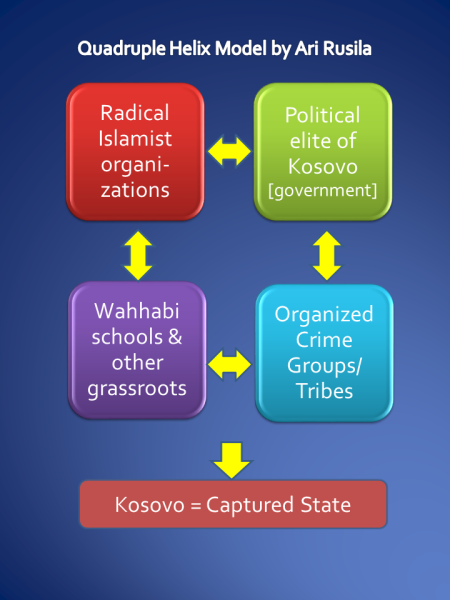
quadruple helix model by Ari Rusila
" data-orig-size="720,960" sizes="(max-width: 450px) 100vw, 450px" data-image-title="QH" data-orig-file="https://arirusila.files.wordpress.com/2008/12/qh.png" data-image-meta="{"aperture":"0","credit":"","camera":"","caption":"","created_timestamp":"0","copyright":"","focal_length":"0","iso":"0","shutter_speed":"0","title":"","orientation":"0"}" width="450" data-medium-file="https://arirusila.files.wordpress.com/2008/12/qh.png?w=225" data-permalink="https://arirusila.wordpress.com/2008/12/07/quadruple-helix-capturing-kosovo/qh-2/" alt="quadruple helix model by Ari Rusila" height="600" srcset="https://arirusila.files.wordpress.com/2008/12/qh.png?w=450&h;=600 450w, https://arirusila.files.wordpress.com/2008/12/qh.png?w=113&h;=150 113w, https://arirusila.files.wordpress.com/2008/12/qh.png?w=225&h;=300 225w, https://arirusila.files.wordpress.com/2008/12/qh.png 720w" class="aligncenter size-full wp-image-4474" data-large-file="https://arirusila.files.wordpress.com/2008/12/qh.png?w=450" />Bottom line
“The recognition of Kosovo was premature and conditioned by great pressure from the former American administration”… “Today, we can see that two-thirds of the international community does not recognize Kosovo … this shows that we are talking about a grave mistake” (Gerhard Schröder)
After Kosovo War international community – UN, EU, etc – tried to re-build some kind of functional society, public services and state in Albanian part of Kosovo, and totally failed to achieve its idea ”standards before status”. In north Kosovo – where most Serbs live – international community also failed but seems that despite this failure the Serbian part has had more positive development. Related to situation in late 1999 – when Western powers helped to ”liberate and save” main parts of Kosovo from Serbs – its seems absurd that now Serbia has become the epicentre of activities in the region and the key factor of peace and stability.
In this early parliamentary election Kosovars desperately try to transform their crime State towards some kind of democracy – to liberate themselves from today’s captured State. I have my doubts about outcome but wish luck for try anyway.
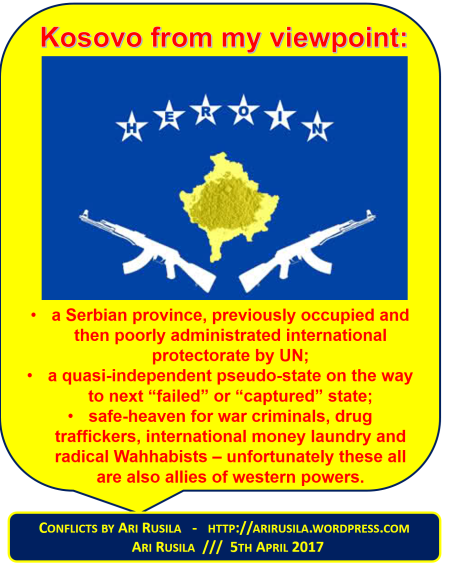
More reading:
IFIMES research: Link (ENG): https://www.ifimes.org/en/9701 (Research – Kosovo 2019 early parliamentary election: the citizens want political changes)
Link (BSH) https://www.ifimes.org/ba/9700 (Analiza – Prevremeni parlamentarni izbori na Kosovu 2019: Građani žele političke promene)
My articles: Kosovo: Two years of Pseudo-state , Balkan route-Business as usual and Captured Pseudo-State Kosovo .
More about link between organized crime and Kosovo political leaders one can find e.g. from “Albanian Terrorism and Oraganized Crime in Kosovo and Metohija (K&M)” , which also can be found from my document library. Related background information can be found also from “leaked” German Intelligence report BND report 2005 which can be found from my document library under Kosovo headline.
The report, “Inhuman treatment of people and illicit trafficking in human organs in Kosovo”, prepared by Swiss prosecutor-turned-politician Dick Marty. Investigations conducted by the Swiss diplomat, Dick Marty on behalf of the Parliamentary Assembly of the Council of Europe (PACE) have revealed the true picture of Kosovo’s prime minister Hashim Thaci. In his report to the PACE’s Commission, Thaci is presented as the leader of a criminal gang engaged in the smuggling of weapons, the distribution of illegal drugs throughout Europe and the selling of human organs for unlawful transplantation. The Swiss senator conducted a two-year inquiry into organised crime in Kosovo after the Council of Europe mandated him to investigate claims of organ harvesting by the Kosovo Liberation Army (KLA) after the war with Serbia ended in 1999.
An exellent article in New York Times – How Kosovo Was Turned Into Fertile Ground for ISIS by Carlotta Gall – gives in deep background info about Kosovo’s transformation from liberal Islam to ground of Islamic extremism
Testimony on the Genesis of Evil – White Book on Albanian terrorism in Kosovo .The book addresses the continuity of terrorist activities by Albanian extremists, beginning with the constituting of the parallel system of Albanian government in Kosovo and Metohija and the pretensions of the so-called Government of the Republic of Kosovo headed by Bujar Bukoshi, covering the founding of FARK and the armed forces of “the Republic of Kosovo”, which united separation-oriented former officers of the former Yugoslav People’s Army, to the founding of the “Kosovo Liberation Army” /KLA/, which at the time of the NATO bombing had more than 20,000 armed members, and the KLA’s transformation and engagement of the former terrorists in the Kosovo Protection Corps.
About possible solutions e.g. my articles Dividing Kosovo – a pragmatic solution to frozen conflict and Cantonisation – a middle course for separatist movements
This article first appeared in Conflicts by Ari Rusila blog

